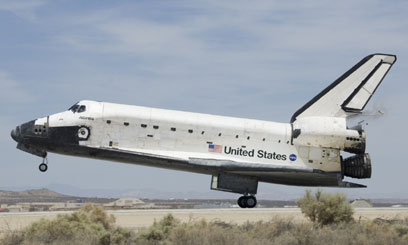WASHINGTON, Jul 3 – The US space shuttle is the most complex and costly flying machine ever built, and although it helped build a pioneering space outpost it also kept Americans confined to low Earth orbit for 30 years.
As the shuttle program prepares to retire after Atlantis takes off toward the International Space Station for a final time in July, the legacy recounted in history books is likely to show both successes and failures, experts say.
"I think the shuttle program record is mixed," John Logsdon, external adviser to the White House and former head of the Space Policy Institute George Washington University, told AFP.
"The highlight of the shuttle program was demonstrating the ability of astronauts to do useful things in space," he said.
"The real failure of the shuttle was to live up to its original promises of being affordable and routine."
The three-decade space shuttle program, NASA\’s most enduring project in its 50 years of existence, cost a total of $208 billion (in 2010 dollars) compared to $151 billion spent on Apollo which put Americans on the moon in 1969.
NASA\’s chief historian Bill Barry recalled that the space shuttle\’s initial aim, when it was formally launched by president Richard Nixon in 1972, was to make spaceflight a possibility for common people, not just the educated elite.
"The original goal… was to make flight into space less expensive, easier and not just a province of highly trained and experienced military test pilots but allow average people go and live in space," said Barry.
But the White House kept pressure on NASA to lower costs as the space agency was designing the shuttle, a process Barry suggests actually drove prices up over the long-term.
"The program was never funded to the level that was expected. Design compromises were made as it was being built. It was never inexpensive or easy to operate," he said.
Nevertheless, the shuttle went on help build a revolutionary orbiting outpost for the world\’s scientists.
Even though it suffered two major disasters when the shuttles Challenger and Columbia exploded in mid-air in 1986 and 2003, the overall memory of the program is likely to be a positive one, Barry said.
"I think future historians will see the shuttle as a spectacular program," Barry said.
"We have done amazing things with the shuttle, the space station, repairs on orbit, Hubble," he said, referring to the Hubble Space Telescope, brought into orbit by Atlantis in 1990 and which has led to major advances in astronomy.
"It\’s a big success," he said, one that has made its way into the popular imagination and inspired the 1979 James Bond film "Moonraker" even before the shuttle took off on its maiden voyage in 1981.
"If you ask average Americans and even (people) around the world to identify how a space ship looks, a lot of school kids will draw something that looks like a space shuttle."
Looking back, the key downfall of the space shuttle program may have been the amount of attention paid to it by NASA for so many years, according to Logsdon.
"I think it was a mistake made back in 1970s to build the program totally around the shuttle — at least the human space program totally around the shuttle," he said.
"It should have been viewed as a first generation experiment… and replaced it a long time ago… probably in the early 1990s after 10 or 15 years of operation."
Logsdon noted that the decision to build the International Space Station was made in 1984 under the administration of then president Ronald Reagan, who wanted it built in a decade.
As it happened, construction on the orbiting space lab did not start until 1998, and the process took the better part of 12 years.
"As long as the US was paying for the shuttle and the ISS there really was no money to develop a replacement vehicle because there was not an enough strong political commitment to provide the resources needed to do that, both," Logsdon said.
With the shuttle program ending, the United States is left with no way to transport astronauts to space until a replacement vehicle can be built by private industry, a process that could take up to 10 years.
NASA chiefs say the end of the shuttle program was inevitable, and that better future spacecraft can be built in cooperation with enterprising competitor companies like Boeing, SpaceX and Sierra Nevada.










































